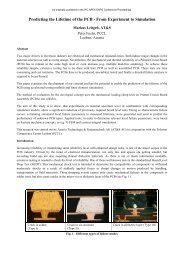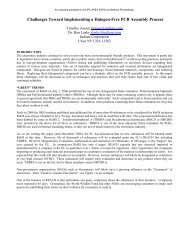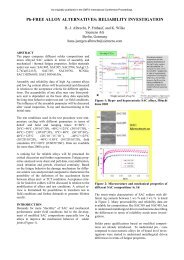Double Reflow-Induced Brittle Interfacial Failures in ... - IPC Outlook
Double Reflow-Induced Brittle Interfacial Failures in ... - IPC Outlook
Double Reflow-Induced Brittle Interfacial Failures in ... - IPC Outlook
- No tags were found...
You also want an ePaper? Increase the reach of your titles
YUMPU automatically turns print PDFs into web optimized ePapers that Google loves.
Figure 10: A warpage displacement map across the overmolded area of Component A measured dur<strong>in</strong>g temperatureramp up at 220°C.Figure 11: A warpage displacement map for the PCB footpr<strong>in</strong>t match<strong>in</strong>g Component A. The measurements weremade dur<strong>in</strong>g temperature ramp up at 220°C.The thermal shadow Moiré data <strong>in</strong> Table 2 <strong>in</strong>dicate a net displacement or warpage of Component A relative to the PCB ofapproximately 4 mils dur<strong>in</strong>g heat<strong>in</strong>g <strong>in</strong> advance of melt<strong>in</strong>g or dur<strong>in</strong>g cool<strong>in</strong>g before solidification takes place (shaded Max. cells <strong>in</strong> Table 2). It must be acknowledged that there are uncerta<strong>in</strong>ties <strong>in</strong> <strong>in</strong>terpret<strong>in</strong>g these displacement measurements.First, these measurements may not reflect the component and PCBA behavior accurately as it would occur dur<strong>in</strong>g an actualfactory reflow cycle. More importantly, the amount of warpage needed to <strong>in</strong>duce solder jo<strong>in</strong>t fracture is unknown. A similaramount of warpage can create other serious BGA defects such as head on pillow (HoP) but HoP is a completely differentfailure mode [6, 7].In most applications 4 mils of warpage would be considered acceptable because defects like HoP and dropped ball would notoccur. On the other hand, solder assembly defects due to warpage can appear with deviations <strong>in</strong> warpage as small as a fewmils [8]. In the case of BGA double reflow, the magnitude of the warpage and <strong>in</strong>duced thermal stress may not be the primaryconsideration. The more important factor may be the strength of the solder <strong>in</strong>terconnection at higher temperatures close tothe melt<strong>in</strong>g and solidification po<strong>in</strong>ts of the solder. Consequently, it is conceivable that a small stress applied to the solderjo<strong>in</strong>t at high temperature when the jo<strong>in</strong>t has its lowest strength could cause a brittle <strong>in</strong>terfacial fracture.Corrective ActionThe obvious path for elim<strong>in</strong>ation of the failures <strong>in</strong> this design was to subject the BGA-side of the PCBA to only a s<strong>in</strong>glereflow pass. This corrective action was implemented successfully. The solder<strong>in</strong>g of the heavy daughter card modules on thenon-BGA side of the board was achieved by modify<strong>in</strong>g other aspects of the assembly process.The root cause analysis and subsequent successful corrective action <strong>in</strong>dicate that <strong>in</strong> order to prevent double reflow defects,BGA components should not be subjected to multiple reflow passes. These double reflow defects could be anothermanifestation of warpage-related assembly defects that are <strong>in</strong>creas<strong>in</strong>g across the <strong>in</strong>dustry. A risk assessment is recommendedwhenever double reflow assembly of BGA components is proposed. The assessment should <strong>in</strong>clude evaluation of dynamicwarpage data for the BGA components used <strong>in</strong> the design.
















